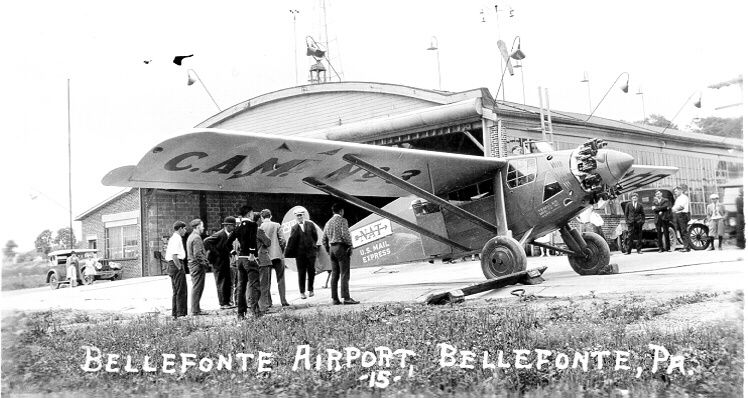 Bellefonte Historical and Cultural
Association
Bellefonte Historical and Cultural
AssociationBellefonte, Pennsylvania
 Bellefonte Historical and Cultural
Association
Bellefonte Historical and Cultural
Association
Bellefonte, Pennsylvania
Fred D Smith Collection of Historic Photos and Postcards of
Bellefonte
The Bellefonte Airfield
BHCA Home | Photo Galleries Home | Virtual Tour Home

Fred D Smith Collection
Before the U.S. Post Office Air Mail Service, little could be called scheduled air delivery. A few nonscheduled routes operated between major cities, but no national commitment existed for mail delivery by air. Then came the end of World War I, and the post office declared its intention to establish a cross-country airmail route. The Army Signal Corps offered to initiate the service. Three months after the inaugural flight on May 15, 1918, the post office took over from the army and continued the service. They ran it until 1927 when they transferred airmail delivery to America's newly organized commercial airlines.
Airmail pilots were the glamour boys of the operation. A breed apart, they were the envy of every kid in the nation who could look up and see a lonely biplane with "U.S. Mail" painted on its fuselage winging its way across the sky. They were the by-the-seat-of-their-pants fliers, the helmet and goggle boys who felt the wind when they flew and heard it singing through the wires and drumming on the fabric of their wings. These earliest of the winged couriers flew as odd an assortment of planes as had ever been assembled. At one time or another the Air Mail Service tried more than 20 types, ranging from German Junkers to Curtiss "Jenny" trainers and World War I bombers. They settled on the British-made de Haviland-4. [from "Remember the Air Mail Pioneers" by Nancy Allison Wright]
During the first years of Air Mail Service, the lessons came fast. Statistics tell the story. In 1921, P.O. officials recorded 1,764 forced landings, about half due to mechanical failures and half due to weather. In that same year, 12 pilots were killed. In all, 32 pilots lost their lives in the nine years of service, approximately one out of every six employed. Determined, however, to prove the mail could be borne on wings despite the hazards, they created milestones that led the way to today's space age wonders.
From 1919 to 1927 Bellefonte was a major refueling stop for mail traveling from New York to Chicago. Flying the fog-shrouded ridges of the Allegheny Mountains in one of the early biplanes with the most primitive of navigational equipment (one pilot famously used a half-empty whiskey bottle strapped to the dash to tell when his wings were level) was a feat of incredible daring and skill -- six pilots would lose their lives flying what was popularly known as the “hell stretch” between 1919 and 1927.The initial stop on the first scheduled westbound air mail flight was made in Bellefonte by Pilot Leon D. Smith on December 18, 1918. The site for the field was chosen by pioneer aviator Max Miller and was in regular use for air mail until 1925. That site is the present Bellefonte High School on East Bishop St.
On Sunday, May 15, 2005, the American Philatelic Society celebrated the heroic era of the pioneer air mail pilots with the dedication of a monument in their honor. The granite monument, erected at the confluence of Logan Branch and Spring Creek, beside the American Philatelic Center (The Match Factory), was the gift of Paul J. Mulvehill, a former pilot with a passion for air mail. The artist who designed the monument was Mike Newcomer.
Click on the thumbnails to enlarge the images:
|
|
|
|
|